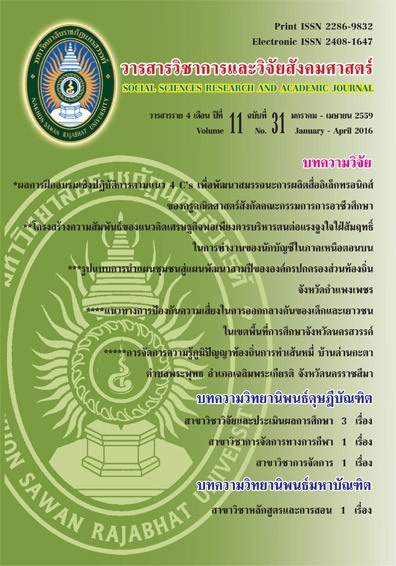แนวทางการป้องกันความเสี่ยงในการออกกลางคันของเด็กและเยาวชนในเขตพื้นที่การศึกษาจังหวัดนครสวรรค์; Preventing the Risk of Dropping out of Children and Youth in the Educational Area, Nakhon Sawan Province
Main Article Content
Abstract
บทคัดย่อ
การวิจัยครั้งนี้มีวัตถุประสงค์เพื่อศึกษาแนวทางการป้องกันความเสี่ยงในการออกกลางคันของเด็กและเยาวชนในเขตพื้นที่การศึกษาจังหวัดนครสวรรค์ กระบวนการวิจัยประกอบด้วย 2 ขั้นตอน คือ 1) ศึกษาปัจจัยเสี่ยงที่ส่งผลต่อการออกกลางคันโดยการสอบถามจากกลุ่ม 382 คน ด้วยแบบสอบถามแบบมามาตราส่วนประมาณค่า 5 ระดับ วิเคราะห์ข้อมูลด้วยสถิติพื้นฐาน ได้แก่ ความถี่ ร้อยละ ค่าเฉลี่ย และส่วนเบี่ยงเบนมาตรฐาน 2) นำเสนอแนวทางการป้องกันความเสี่ยงในการออกกลางคันของเด็กและเยาวชนในเขตพื้นที่การศึกษาจังหวัดนครสวรรค์ โดยการจัดสนทนากลุ่มโดยผู้เชี่ยวชาญจำนวน 7 คน
ผลการวิจัยพบว่า ปัจจัยเสี่ยงที่ส่งผลต่อการออกกลางคันของเด็กและเยาวชนในเขตพื้นที่การศึกษาจังหวัดนครสวรรค์ โดยภาพรวมอยู่ในระดับปานกลาง ซึ่งอันดับสูงสุด ได้แก่ ปัจจัยเสี่ยงด้านผู้เรียน รองลงมาคือปัจจัยเสี่ยงด้านสังคมและสภาพแวดล้อม ปัจจัยเสี่ยงด้านครูและสถานศึกษา และปัจจัยเสี่ยงด้านครอบครัว ตามลำดับ
ส่วนแนวทางการป้องกันความเสี่ยงในการออกกลางคันของเด็กและเยาวชนในเขตพื้นที่การศึกษาจังหวัดนครสวรรค์ ประกอบด้วย 4 ด้าน ดังนี้ 1) ด้านครอบครัว ควรส่งเสริมเด็กและเยาวชนมีรายได้เสริมระหว่างเรียน ให้ความรู้เรื่องการบังคับใช้กฎหมายการศึกษาภาคบังคับ และมีการประชาสัมพันธ์ให้ผู้ปกครองเห็นความสำคัญของการศึกษามากกว่าเดิม 2) ด้านครูและสถานศึกษา สถานศึกษาควรจัดให้มีนโยบายติดตามและเฝ้าระวังเด็กและเยาวชนที่ขาดเรียนบ่อยๆอย่างจริงจังเป็นรูปธรรมและเป็นระบบอย่างต่อเนื่อง มีการอบรมครูเพื่อทำหน้าที่ครูที่ปรึกษาและครูแนะแนวอย่างสม่ำเสมอ 3) ด้านผู้เรียน ควรส่งเสริมการสอนซ่อมเสริมให้กับเด็กและเยาวชนที่มีผลการเรียนต่ำ เน้นการใช้สื่อการสอนที่หลากหลายตามความเหมาะสมของระดับชั้น และอบรมให้เด็กและเยาวชนได้รู้จักป้องกันการมีบุตรก่อนวัยอันควรและความสัมพันธ์กับเพื่อนต่างเพศ และ
4) ด้านสังคมและสภาพแวดล้อม ส่งเสริมการจัดสื่อการเรียนการสอนให้กับโรงเรียนอย่างเพียงพอ ร่วมมือกับทุกฝ่ายในการดูแลช่วยเหลือนักเรียนอย่างทั่วถึงรวมถึงผู้ปกครอง ผู้นำชุมชน และชุมชนเอง
Abstract
This research aims to study Risk factors and ways to prevent the risk of dropping out of children and youth in Nakhon Sawan Educational Service Area. It consists of two phases: 1) To study the risk factors affecting on dropout rate of children and youth from the sample group of 382 people. The tools used to collect the data in this study are questionnaires with five levels of rating scale. Data were analyzed by basic statistics method as frequency, percentage, average and standard deviation. 2) To propose the school dropout risk prevention guidelines of youth and children in Nakhon Sawan Educational Service Area by setting a discussion of the focus group of seven specialists.
The research found that risk factors that can affect the dropout rate of children and youth in Nakhon Sawan Educational Service Area is prospectively at a middle level. The highest risk factors were on learners, social and environmental factors and school and teachers factors respectively.
And the school dropout risk prevention guidelines of youth and children in Nakhon Sawan Educational Service Area family risk factors consist of four aspects: 1) Family conditions: Schools should encourage children and youths to do a part-time job to earn extra income while studying and should instill the children about the knowledge of compulsory education law enforcement. 2) Teachers and schools conditions: Education policy should provide for monitoring and surveillance of children and youth who frequently wake absences conscientiously as a materialistic and systematic process. 3) Learners conditions: The school should encourage students to retest for children and youth with low academic performance. Emphasize on teaching with a variety of media appropriated to a variation of classrooms. Instill children and youth of teen pregnancy awareness. 4) Social and environmental conditions: Schools should provide teaching materials adequately and cooperate with all parties to aid students, parents, community leaders and the community.


